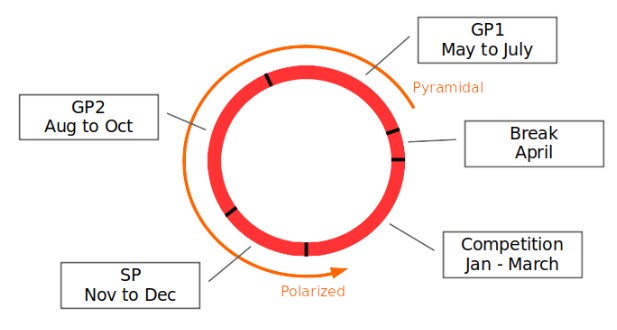
High level cross country skiers don’t train with the same distribution (TID) all year round. A year is split into a macro-cycle of recovery, endurance, intensity and competition.
A study showed that after a short break following the end of the competition phase cross country skiers would start an initial period of general preparation (GP) with around 55 hours per month spent training.
The purpose of the general preparation period is to improve the athlete’s general fitness level and work capacity and to maximize adaptability in preparation for a high level of training. In addition, excessive high-intensity training and a large volume of training during the preparation period can cause muscle injury and overtraining. The GP phases also works a lot on core strength and stability with gym work.
Approximately 60% of the total training time is performed during the general preparation period between May and October. This period typically includes high volumes of LIT and 50–60% of the endurance-training conducted as sport-specific exercise (e.g., roller skiing and skiing), with the remainder mainly performed as running

GP initially follows a Pyramidal distribution. That is more medium intensity (Z2) than high intensity (Z3) work (90/6/4). Note that 90% of training time is still spent at Z1. From August there are more Z3 intervals and less time spent in Z2 (91/4/5). The Specific Preparation for competition (SP) is heavily polarized between Z1 and Z3 (88/4/8) and this continues to the competition phase (CP) but with an important reduction in time spent at Z1 (85/5/10). Cross country skiing also lends itself to micro-cycles. For example a morning strength building session could focus on the upper body and in the afternoon skate work might be primarily with the legs. Polarized training is, in itself, a micro-cycle as HIT days will be split by one or more LIT days. A number of different micro-cycles form a meso-cycle. For example 21 days on the glacier at altitude skiing with afternoon in the valley running or cycling may be a VO2max mesocycle. Most XC skiers use a traditional model, alternating between high- and low-volume weeks. Meso-cycles are typically 3 to 4 weeks in length and may be designed differently for male and female athletes.